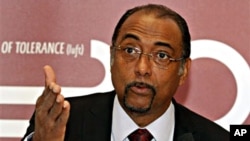A new U.N. report says that despite significant gains in the prevention and treatment of HIV - the virus that causes AIDS - 7,000 people are still infected each day, 1,000 of whom are children. Although that number is high, it reflects a nearly 25 percent decline in new infections worldwide in the past decade.
The study, which marks 30 years since the global AIDS epidemic began, touts the progress made in battling the virus, but notes that there is still a long way to go to reach the goal of “triple zero” - that is zero new infections, zero discrimination against those with the virus, and zero AIDS-related deaths.
UNAIDS estimates that approximately half the 34 million people living with HIV do not know they are infected. UNAIDS Executive Director Michel Sidibé says this is a major problem, because early treatment can lead to a longer life and prevent transmission to others.
“With access to treatment, AIDS have moved from what was effectively a death sentence to a chronic disease," said Sidibé.
For those who do know their status, access to treatment is growing. The report notes that some 6.6 million people in low- and middle-income countries were receiving antiretroviral treatment at the end of last year - nearly 22 times the number in 2001.
Sidibé underscored the importance of early treatment, citing the results of a recent study at the U.S.-based National Institutes of Health.
“Two weeks ago the discovery from NIH showing clearly that when you are putting people on treatment early [it] is a game changer. It is first showing that this wrong dichotomy which was existing between treatment versus prevention is not anymore useful," he said. "Because you can reduce by 96 percent - I said 96 percent - the number of new infection[s] if you are able to treat people early. And you can reduce also the side effects, which is very important because we know that the death rate is mainly higher when people are not put early on treatment.”
The report notes that while infection rates are down, treatment is expanding and education and awareness are growing, these gains could be reversible without sufficient funding and political commitment.
Next week, some 30 presidents and prime ministers will join other international leaders at U.N. headquarters to take stock of current commitments and chart the future course of the global AIDS response.
U.N. Deputy Secretary-General Asha-Rose Migiro says the high-level meeting will help propel the international community toward the “triple zero” goal.
“We expect to have concrete steps whereby 2015, by 2020, we are in a world where HIV and AIDS is not stigmatized, but we have reduced new infections, we have reduced discrimination - we have eliminated discrimination - and we have eliminated AIDS-related deaths," said Migiro.
The deputy secretary-general underscored the international community is poised to move farther and faster toward creating a world free of HIV and AIDS.
UN: AIDS Response at Crossroads 30 Years On










